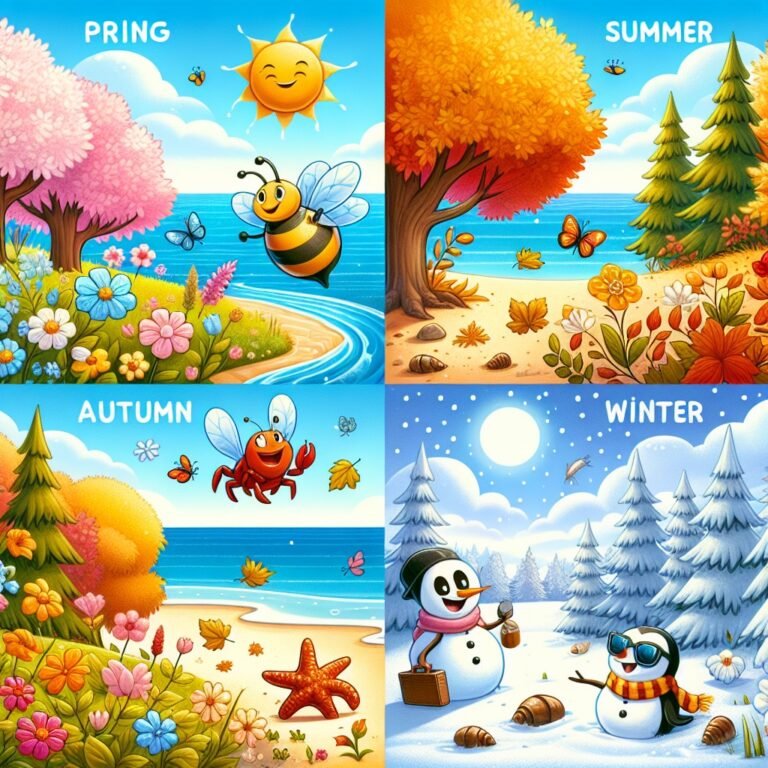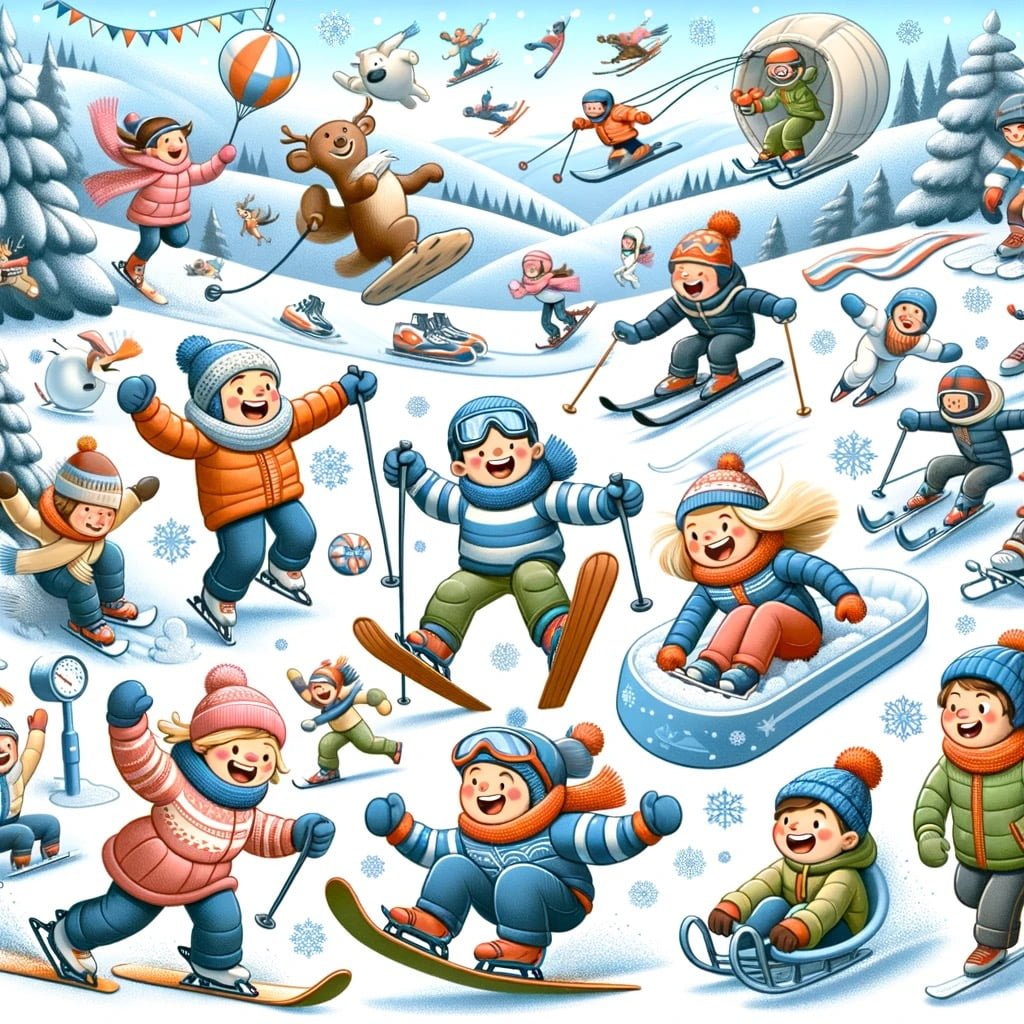Welcome to a world of fascinating Fun Facts for Kids About Seasons! As an expert in popular science, you understand the importance of sparking curiosity and encouraging young learners to explore the wonders of the natural world. In this engaging blog post, you will uncover the captivating mysteries behind the changing seasons and how they impact our planet. From the Earth’s tilt causing seasonal shifts to the unique climate patterns in the tropics, each fun fact is a gateway to understanding the beauty and diversity of our planet’s ecosystem. Join us on a journey of exploration and discovery as we delve into the enchanting world of seasons and learn how they influence everything from plant growth to animal adaptations. Get ready to be inspired and educated as we unravel the magic of Fun Facts for Kids About Seasons!
Fun Facts for Kids About Seasons
1. The Earth’s Tilt Causes Seasons

For younger kids: The Earth is like a spinning top and it wobbles. This makes the weather change!
For older kids: The Earth is tilted on its axis, causing different parts of the globe to receive more or less direct sunlight at different times of the year, resulting in the seasons we experience.
Detailed explanation:One of the most fascinating Fun Facts for Kids About Seasons is how the Earth’s tilt plays a crucial role in causing the changes in weather patterns and temperatures throughout the year. The Earth is tilted on its axis at an angle of approximately 23.5 degrees. This tilt is responsible for the four distinct seasons that we experience – spring, summer, fall, and winter.
As the Earth orbits around the sun, different parts of the planet receive varying amounts of sunlight at different times of the year. When the Northern Hemisphere is tilted towards the sun, it experiences summer, with longer days and warmer temperatures. Conversely, when the Northern Hemisphere is tilted away from the sun, it experiences winter, with shorter days and colder temperatures. The opposite is true for the Southern Hemisphere.
During the spring and fall equinoxes, the Earth is positioned so that both hemispheres receive an equal amount of sunlight, resulting in milder temperatures and more moderate weather. This is why these seasons are often considered transitional periods between the extremes of summer and winter.
Understanding the Earth’s tilt and how it causes the changing seasons is not only important for grasping basic scientific concepts, but it also highlights the interconnectedness of the natural world. From the migration patterns of animals to the growth cycles of plants, the changing seasons impact all living organisms on Earth. So next time you enjoy the warmth of summer or the beauty of fall foliage, remember to thank the Earth’s tilt for making it all possible. Fun Facts for Kids About Seasons make learning about science enjoyable and engaging.
Fun Facts for Kids About Seasons
2. Seasons Change Due to the Earth’s Orbit
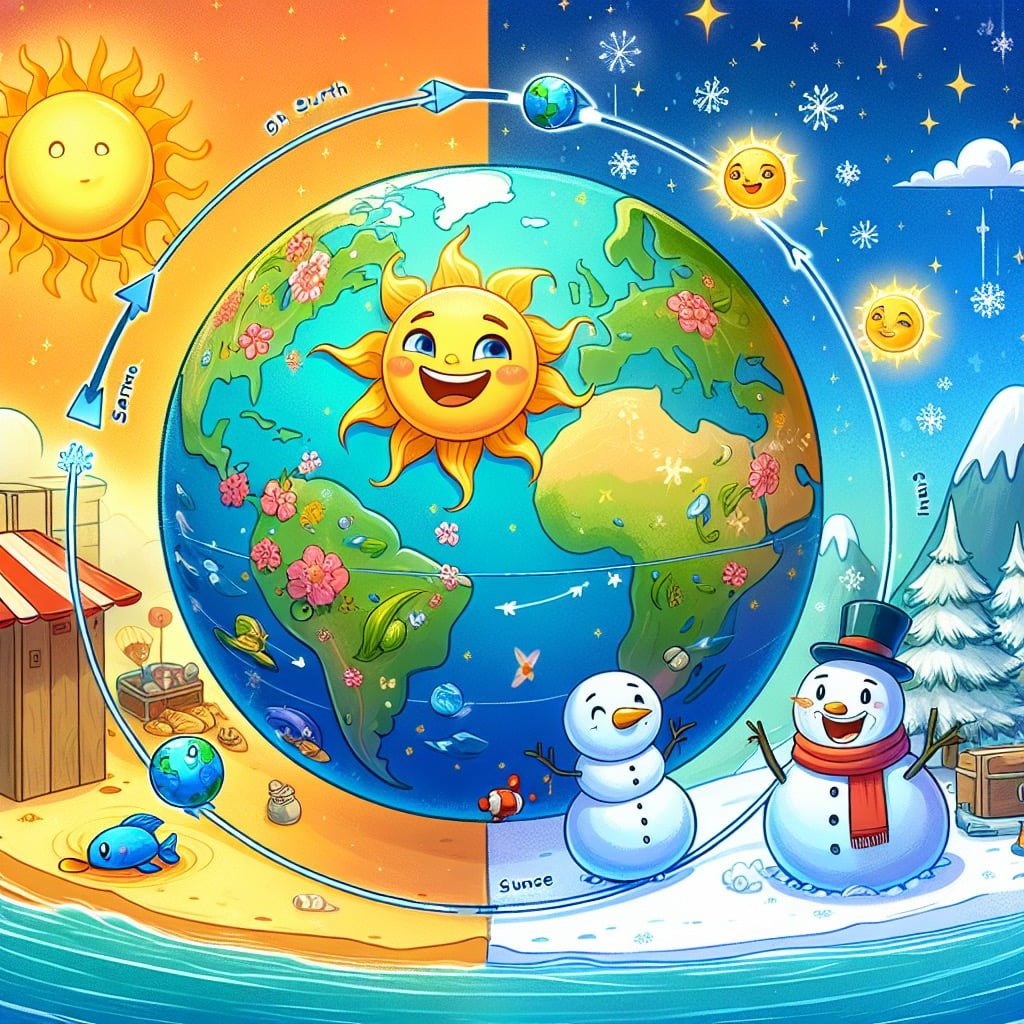
For younger kids: The Earth travels around the Sun, and that’s what makes it hot and cold at different times!
For older kids: The Earth’s orbit around the Sun affects the length of daylight and the angle at which sunlight reaches the planet, resulting in the four distinct seasons.
Detailed explanation:Seasons change due to the Earth’s orbit around the sun, a process that takes approximately 365.25 days to complete. This orbit is not a perfect circle; instead, it is elliptical, which means the Earth gets closer to and farther from the sun at different points in its orbit. However, this distance has little to do with the changing seasons.
What actually causes the seasons to change is the tilt of the Earth’s axis. The Earth is tilted at an angle of about 23.5 degrees relative to its orbit around the sun. As a result, different parts of the Earth receive varying amounts of sunlight throughout the year. When a particular hemisphere is tilted towards the sun, it receives more direct sunlight and experiences summer. When it is tilted away from the sun, it receives less direct sunlight and experiences winter. The opposite hemisphere experiences the opposite season at the same time.
Transitioning between these seasons is what gives us spring and fall. During the equinoxes, which occur in March and September, the Earth is neither tilted towards nor away from the sun, resulting in roughly equal amounts of sunlight for both hemispheres and mild temperatures globally. These transitions are marked by the changing length of daylight hours and the position of the Sun in the sky.
Understanding how the Earth’s orbit and axial tilt affect the changing seasons can provide a fascinating perspective on the natural world. Fun facts for kids about seasons can spark their curiosity and help them appreciate the intricate mechanisms that govern our planet’s climate. By observing these phenomena, we can deepen our understanding of the Earth and its place in the solar system.
Fun Facts for Kids About Seasons
3. Different Parts of the World Have Opposite Seasons
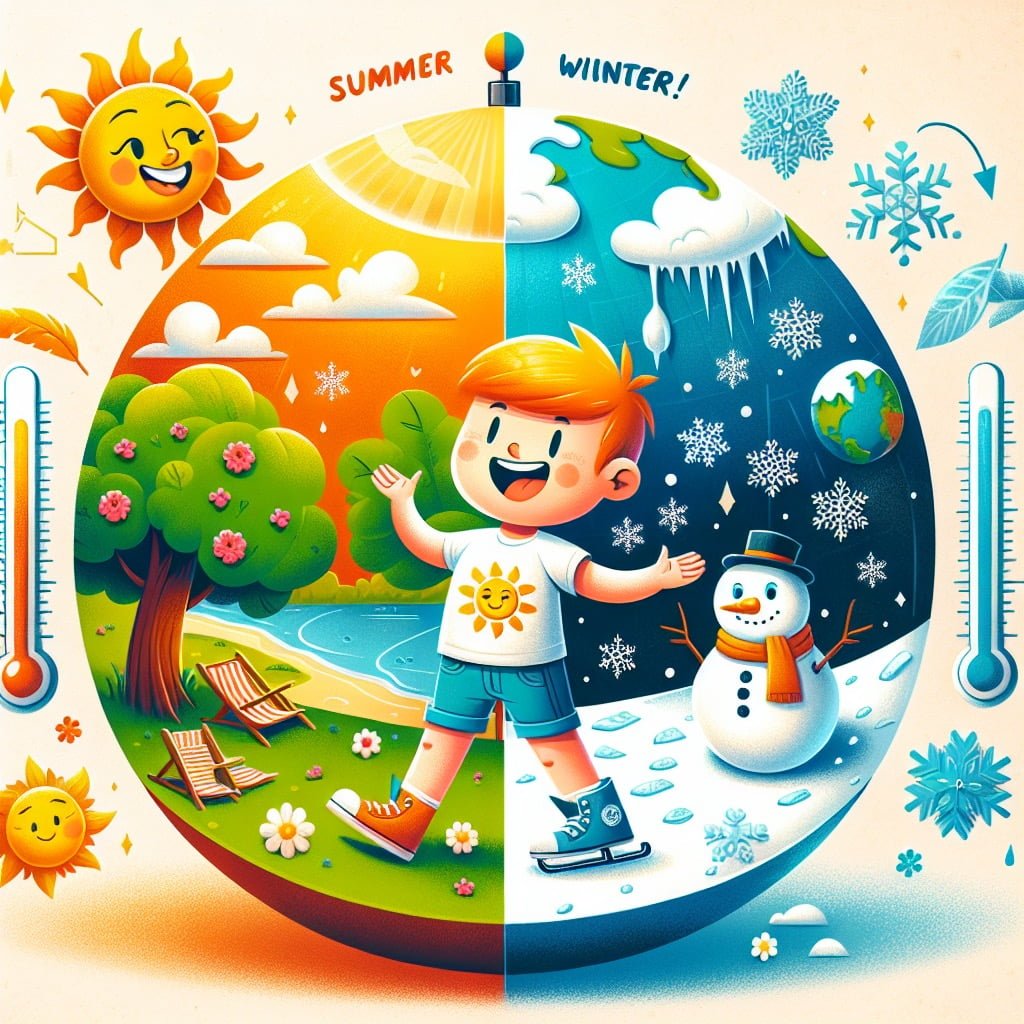
For younger kids: When it’s summer here, it’s winter in some other countries!
For older kids: While we enjoy summer in one hemisphere, the opposite hemisphere experiences winter due to the tilt of the Earth’s axis, showcasing the diversity of seasonal patterns across the globe.
Detailed explanation:One of the fascinating Fun Facts for Kids About Seasons is that different parts of the world have opposite seasons. This is due to the tilt of the Earth’s axis in relation to its orbit around the sun.
When one hemisphere is tilted toward the sun, it receives more direct sunlight and experiences warmer temperatures, leading to summer. At the same time, the opposite hemisphere is tilted away from the sun, receiving less direct sunlight and experiencing cooler temperatures, leading to winter. This is why countries in the Northern Hemisphere, such as the United States and Europe, have summer from June to August while countries in the Southern Hemisphere, such as Australia and South Africa, have winter during the same months.
The tilt of the Earth’s axis also causes the changing of seasons throughout the year. As the Earth continues its orbit around the sun, the hemispheres gradually switch positions, leading to the opposite seasons. This cycle of changing seasons is essential for maintaining the balance of ecosystems and influencing weather patterns around the world.
It is truly remarkable to think about how the tilt of the Earth’s axis can create such diverse and opposite seasons in different parts of the world. This phenomenon not only impacts the weather and environment but also plays a significant role in shaping cultural traditions and activities in various regions. Next time you experience a season, take a moment to appreciate the scientific marvel behind it.
Fun Facts for Kids About Seasons
4. The Equator Has Consistently Warm Weather

For younger kids: The equator is like a never-ending summer vacation spot!
For older kids: Due to its direct exposure to the Sun’s rays, the equator experiences relatively consistent warm temperatures throughout the year, resulting in a perpetual summer-like climate.
Detailed explanation:One fun fact for kids about seasons is that the Equator has consistently warm weather throughout the year. This is due to the way the Earth is tilted on its axis and how the sun’s rays hit the planet.
The Equator is an imaginary line that runs around the Earth at its widest point, dividing the planet into the Northern Hemisphere and the Southern Hemisphere. Because the Equator is located at the middle of the Earth, it receives direct sunlight year-round. This means that the Equator experiences relatively equal lengths of day and night throughout the year, resulting in a consistent climate with warm temperatures.
Unlike areas closer to the poles, where the tilt of the Earth causes significant changes in sunlight and temperature throughout the year, regions near the Equator enjoy a more stable and predictable climate. This is why places like the Amazon Rainforest and countries in Africa near the Equator tend to have hot and humid weather all year long.
In addition to the direct sunlight it receives, the Equator also benefits from the fact that the sun’s rays hit it at a more direct angle, maximizing the amount of heat energy absorbed. This phenomenon helps maintain warm temperatures and the lush vegetation found in Equatorial regions.
Overall, the Equator’s consistently warm weather is a fascinating aspect of Earth’s climate that can teach kids about the importance of the planet’s tilt and position in relation to the sun.
Fun Facts for Kids About Seasons
5. Animals Adapt to Different Seasons
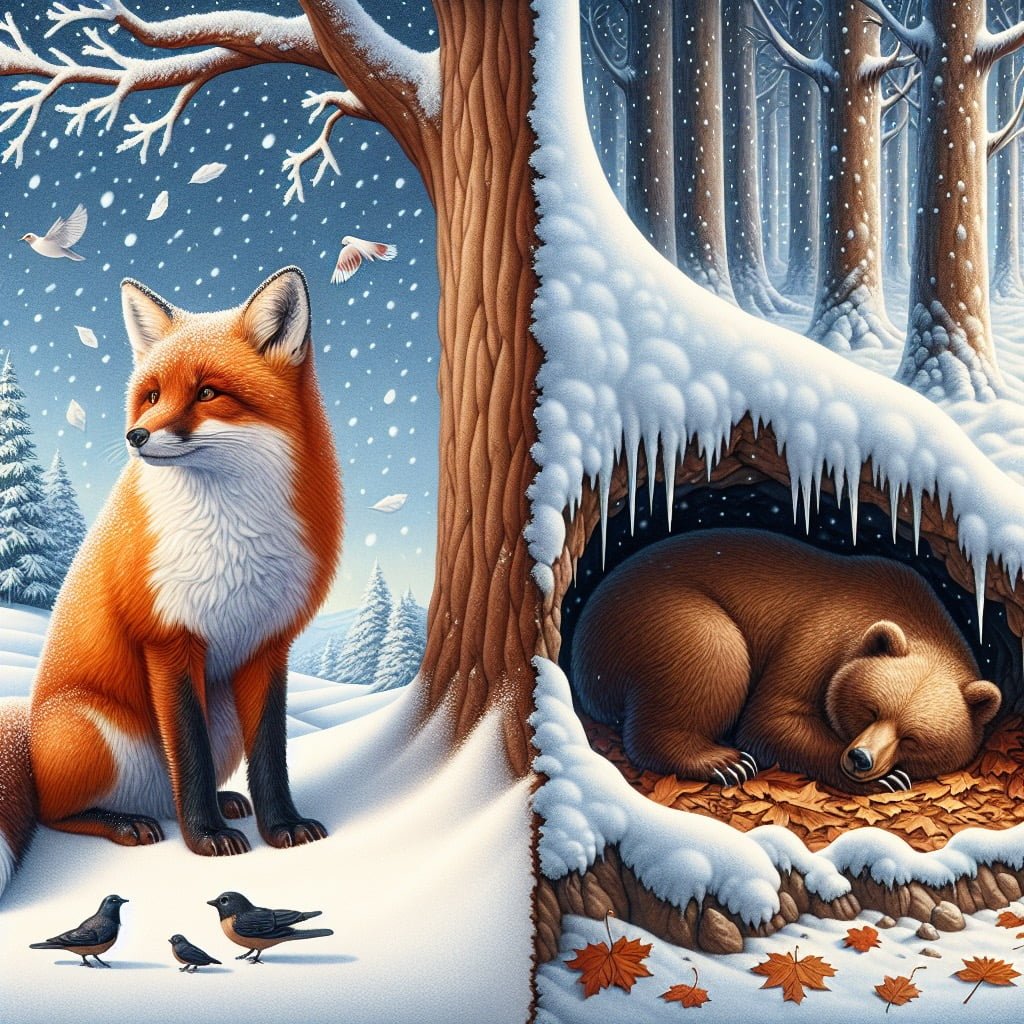
For younger kids: Some animals grow thicker fur or hibernate when it gets cold!
For older kids: Animals have evolved various physical and behavioral adaptations to cope with seasonal changes, such as shedding and growing thicker fur, hibernating, or migrating to different areas.
Detailed explanation:Animals are incredibly adaptable creatures that have evolved over time to survive and thrive in different environments and climates. One fascinating aspect of this adaptability is how animals adjust to the changing seasons. Fun Facts for Kids About Seasons include examples of how various species have developed unique strategies to cope with the challenges posed by different times of the year.
One common adaptation seen in many animals is the ability to change their fur or coat thickness depending on the season. For example, in colder months, animals like the Arctic fox grow thick, insulating fur to keep warm, while in warmer months, they shed this fur to prevent overheating. This change in coat thickness helps these animals regulate their body temperature and stay comfortable in different seasons.
Another interesting adaptation is migration, which is a behavior seen in a wide range of animals, from birds to whales to butterflies. These animals travel long distances to find food, reproduce, or escape harsh weather conditions. Migration allows them to take advantage of seasonal changes in temperature and resources, ensuring their survival.
Some animals also hibernate during the winter months, entering a state of dormancy where their metabolic rate drops, and they conserve energy. Bears, for example, stock up on food in the fall and then hibernate in their dens until spring, when food becomes more abundant again.
Overall, the ability of animals to adapt to different seasons is a testament to the incredible diversity and resilience of the natural world. Understanding how animals cope with seasonal changes can provide valuable insights into the delicate balance of ecosystems and the importance of conservation efforts to protect these amazing creatures. Fun Facts for Kids About Seasons can help children appreciate the wonders of nature and inspire them to learn more about the world around them.
Fun Facts for Kids About Seasons
6. The Tropics Only Have Wet and Dry Seasons

For younger kids: In the tropics, it’s either rainy or sunny—no in-between!
For older kids: Unlike temperate regions with four distinct seasons, the tropics experience a wet season with heavy rain and a dry season with minimal rainfall, showcasing a unique seasonal pattern.
Detailed explanation:The tropics only have wet and dry seasons, as opposed to the four distinct seasons experienced in temperate regions. This phenomenon is due to the unique climate patterns found near the equator.
In the tropics, the two primary seasons are a reflection of the movement of the Intertropical Convergence Zone (ITCZ). The ITCZ is a band of low pressure that encircles the Earth near the equator, where the trade winds from the Northern and Southern Hemispheres converge. As the ITCZ shifts north and south throughout the year, it brings with it changes in precipitation patterns.
During the wet season, the ITCZ moves towards the hemisphere experiencing summer, bringing heavy rainfall and humid conditions. This is when the tropics experience their highest precipitation levels, leading to lush vegetation and vibrant ecosystems. On the other hand, during the dry season, the ITCZ moves away from the region experiencing summer, resulting in reduced rainfall and drier conditions. This can lead to droughts and wildfires in some areas, as vegetation struggles to survive without regular moisture.
Overall, the presence of only wet and dry seasons in the tropics is a fascinating aspect of Earth’s climate system. Understanding these unique patterns can help us appreciate the diversity of climates found around the globe, and how they impact the ecosystems and societies that call these regions home.
In conclusion, the tropics’ exclusive wet and dry seasons are just one of the many interesting Fun Facts for Kids About Seasons that showcase the complexity and beauty of our planet’s climate system.
Fun Facts for Kids About Seasons
7. Seasons Affect Plant Growth and Flowering
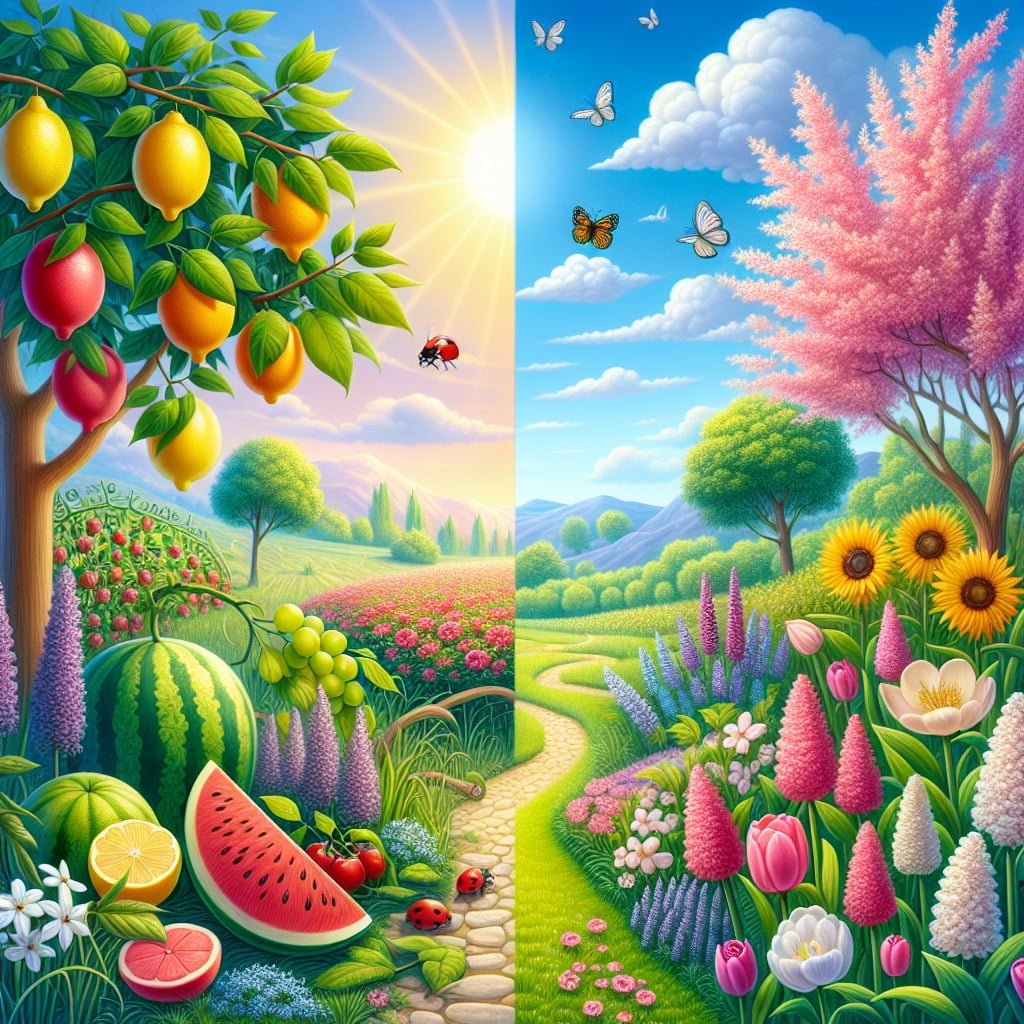
For younger kids: Some plants grow fruits during summer and fall, while others bloom in the spring!
For older kids: Seasons play a crucial role in initiating processes such as flowering, fruiting, and dormancy in plants, influencing their growth and reproductive cycles.
Detailed explanation:Seasons play a crucial role in the growth and flowering of plants. This phenomenon is not only interesting but also educational, making it a fascinating topic for kids to learn about. In fact, understanding how seasons affect plant growth and flowering can provide valuable insights into the natural world around us.
One of the main ways in which seasons impact plant growth is through changes in temperature. Different plants have specific temperature requirements for optimal growth, and these requirements can vary depending on the season. For example, many plants go dormant during the winter months, when temperatures drop and sunlight is scarce. In contrast, plants may thrive during the warmer months of spring and summer, when the temperature is higher and sunlight is abundant.
Another way in which seasons affect plant growth is through changes in daylight hours. The length of daylight can trigger certain physiological processes in plants, such as flowering. Many plants require a certain amount of daylight to flower, and this trigger is often tied to the changing seasons. For example, some plants may only flower during the long days of summer, while others may bloom in the shorter days of autumn.
Overall, understanding how seasons affect plant growth and flowering can provide valuable insights into the natural world. By learning about this phenomenon, kids can gain a greater appreciation for the environment around them and the importance of seasonal changes in the plant kingdom. Fun Facts for Kids About Seasons can be a great way to introduce children to the fascinating world of plants and how they are influenced by the changing seasons.
Fun Facts for Kids About Seasons
8. Daylight Saving Time Changes Seasonal Daylight
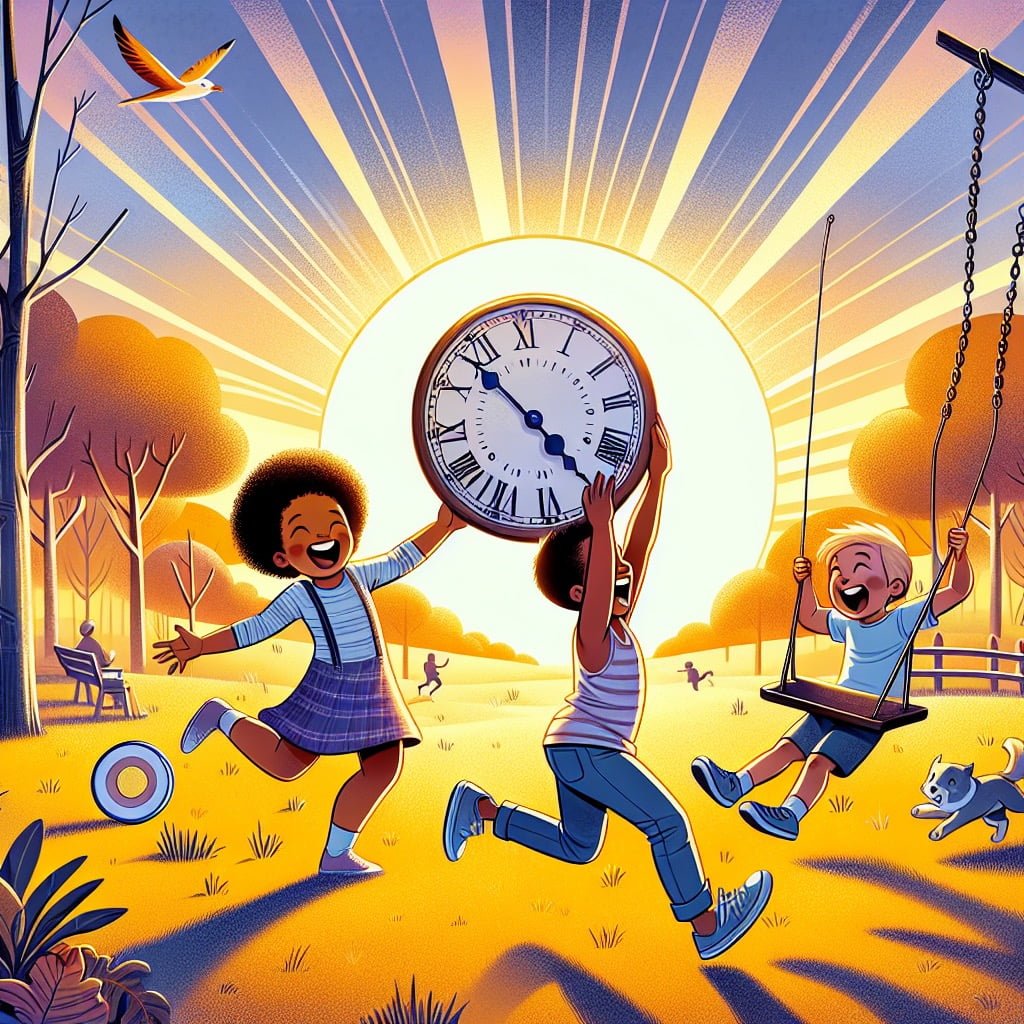
For younger kids: We change the clocks to have more playtime when it’s sunny!
For older kids: Daylight Saving Time adjusts the clocks to make better use of daylight, resulting in longer evenings during the warmer months and shorter evenings in winter.
Detailed explanation:One interesting fun fact for kids about seasons is how daylight saving time changes the amount of daylight we experience during different seasons. Daylight saving time is a practice where clocks are set ahead by one hour during the warmer months to extend evening daylight. This means that during daylight saving time, we have more daylight in the evenings compared to the mornings.
In the spring, when daylight saving time begins, the days start to get longer as we move towards summer. This means that we get to enjoy more daylight in the evenings for outdoor activities like playing at the park, going for a bike ride, or having a family barbecue. This change in daylight can also affect our energy levels and mood, as more sunlight exposure can help regulate our body’s internal clock and improve our overall well-being.
On the other hand, when daylight saving time ends in the fall, we “fall back” by setting our clocks back one hour. This means that we experience earlier sunsets and shorter days as we move towards winter. With less daylight in the evenings, we may find ourselves spending more time indoors and adjusting to the earlier darkness. It’s important to be mindful of these changes in daylight and make adjustments to our routines accordingly.
Overall, daylight saving time plays a role in changing the seasonal daylight we experience throughout the year. It’s a fun and fascinating fact about how we interact with the changing seasons and the natural rhythms of the Earth.
Fun Facts for Kids About Seasons
9. The Southern and Northern Hemispheres Have Opposite Seasons

For younger kids: When we have snow, kids on the other side of the world are playing outside in the sun!
For older kids: While it’s summer in one hemisphere, it’s winter in the other due to the opposite orientation of the Earth’s axis, demonstrating the inverse seasonal patterns in the Northern and Southern Hemispheres.
Detailed explanation:One of the fascinating Fun Facts for Kids About Seasons is that the Southern and Northern Hemispheres experience opposite seasons. This phenomenon is a result of the Earth’s tilt on its axis as it orbits around the sun.
During the summer months in the Northern Hemisphere, the Earth is tilted towards the sun, leading to longer days, warmer temperatures, and overall more sunlight. This is why countries like the United States, Canada, and Europe experience summer from June to August. Meanwhile, in the Southern Hemisphere, the Earth is tilted away from the sun during this time, resulting in shorter days, cooler temperatures, and winter weather.
Conversely, when it is winter in the Northern Hemisphere, countries like Australia, Argentina, and South Africa are experiencing their summer months. This is because the Earth’s tilt causes the sun’s rays to hit the Southern Hemisphere more directly, creating warmer weather and longer days.
These opposite seasons create a unique dynamic on our planet, showcasing the diversity and complexity of Earth’s natural systems. It also highlights the interconnectedness of all living things, as the changing seasons play a crucial role in the life cycles of plants and animals around the world.
In conclusion, the fact that the Southern and Northern Hemispheres have opposite seasons is not only a fun tidbit for kids to learn, but it also teaches us about the intricate relationship between the Earth, the sun, and the changing of the seasons.
Fun Facts for Kids About Seasons
10. Different Cultures Celebrate Seasonal Festivals
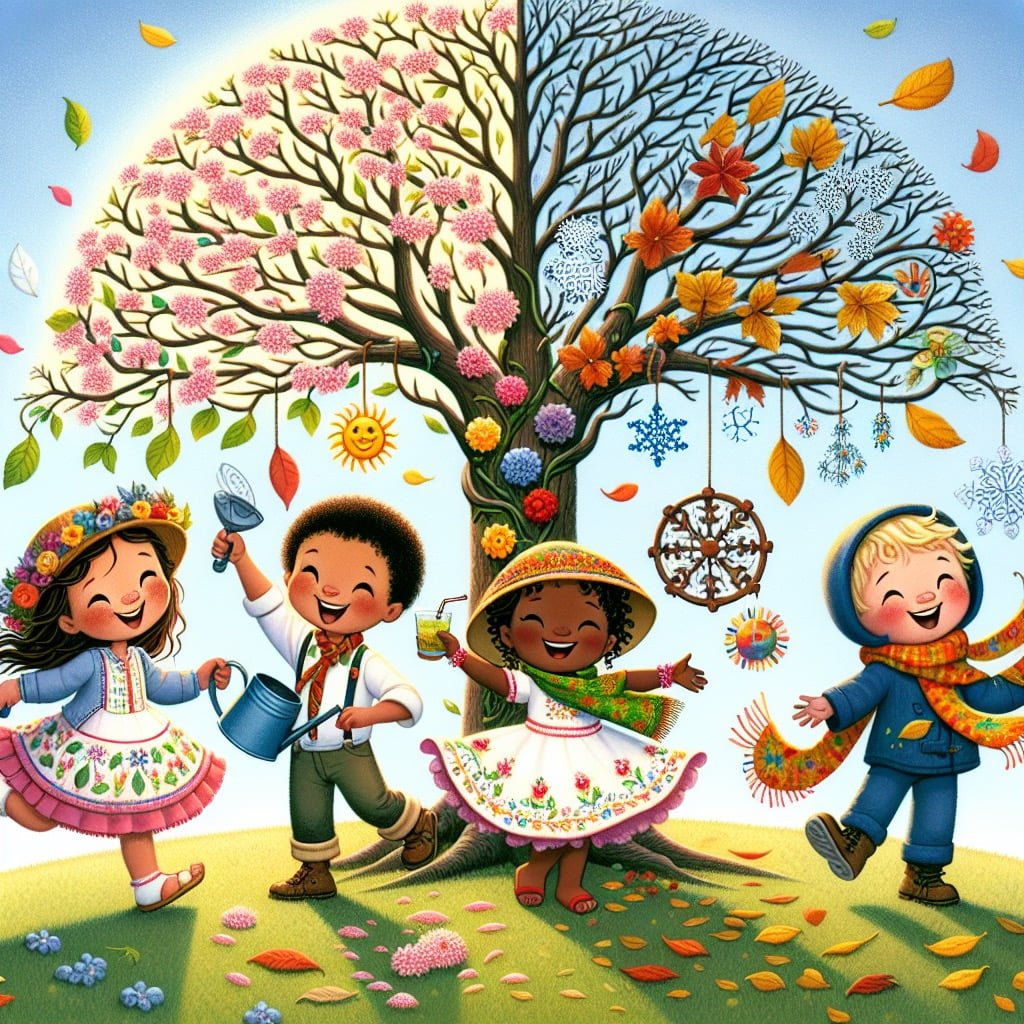
For younger kids: Some countries have special parties when the seasons change!
For older kids: Many cultures around the world commemorate seasonal transitions with festivals, rituals, and events, often showcasing unique traditions and customs associated with each season.
Detailed explanation:Seasonal festivals are celebrations that mark the changing of seasons and are often deeply rooted in cultural traditions. These festivals are observed around the world by different cultures, each putting their own unique spin on the festivities. From the vibrant colors of Holi in India to the lantern-lit Mid-Autumn Festival in China, these celebrations serve as a way for communities to come together and honor the cycles of nature.
One of the most fascinating aspects of seasonal festivals is how they reflect the values and beliefs of a particular culture. For example, in Japan, the cherry blossom festival (Hanami) is a time of reflection on the transience of life and the beauty of impermanence. In contrast, the Oktoberfest in Germany is a lively celebration of harvest and community, complete with beer tents and folk music.
These seasonal festivals also provide a way for people to connect with nature and appreciate the changing seasons. In many cultures, the rituals and traditions associated with these festivals are passed down through generations, creating a sense of continuity and belonging.
Overall, seasonal festivals are a wonderful way to learn about different cultures and their unique ways of celebrating nature and the changing seasons. So next time you come across a seasonal festival, take a moment to join in the festivities and learn more about the Fun Facts for Kids About Seasons.
Did You Know?
Certain animals, like birds and butterflies, migrate thousands of miles each year to reach warmer or cooler destinations, allowing them to follow the favorable climate of each season.
‘Fun Facts for Children about the Seasons’
Have you ever wondered why some animals hibernate in the winter or why certain plants go dormant in the cold months? Seasons play a vital role in the Earth’s ecosystem, influencing not only the weather patterns but also the behavior of plants, animals, and even humans. By learning more about seasons, kids can develop a deeper appreciation for the natural world and gain a greater understanding of how everything is interconnected.
But it’s not just about the science – delving into the fascinating world of seasonal changes can also uncover a treasure trove of cultural traditions and celebrations tied to specific times of year. From celebrating Nowruz during the spring equinox to festivals of light like Diwali during the winter solstice, each season brings its own unique customs and festivities.
Exploring fun facts about seasons can spark curiosity and inspire a sense of wonder about the world around us. By delving into the captivating world of seasons, kids can enrich their learning experience and discover the magic that each season brings. So, let’s dive into the world of seasons together and uncover the wonders that await!
Sources and additional information for Fun Facts for Kids About Seasons
WikipediaBritannicaHistory of Holidays (History.com)Time and Date HolidaysThe Old Farmer’s Almanac – SeasonsEarthSky – Earth’s SeasonsNational Geographic – The Science of WinterHoliday InsightsSeasons of the YearOffice HolidaysWhy Christmas?History ChannelTime and DateHallmark ChannelBritannicaWikipediaThe Spruce CraftsMartha StewartGood Housekeeping
